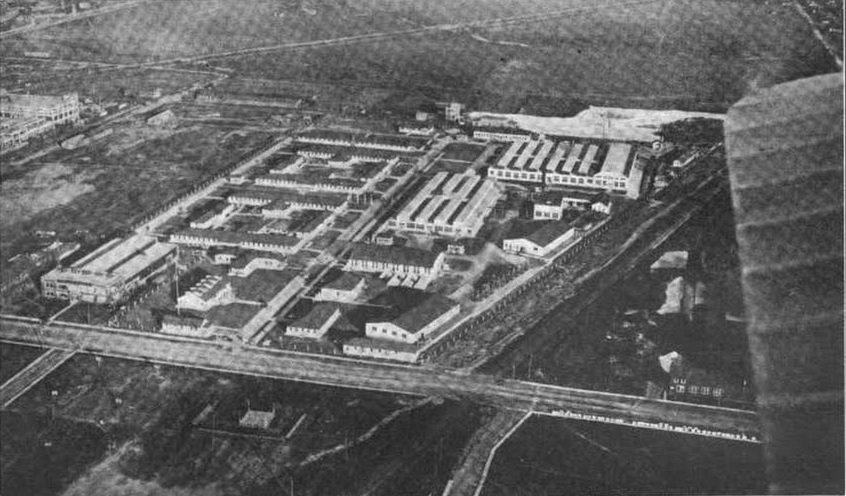
May is finally here and with it racing fans from around the world will soon begin flocking to the Indianapolis Motor Speedway to attend practices and qualifying races in preparation for the Indianapolis 500. For the past century, the Speedway ─ both the track and the adjacent areas of the town ─ have become synonymous with motorsports and racing.
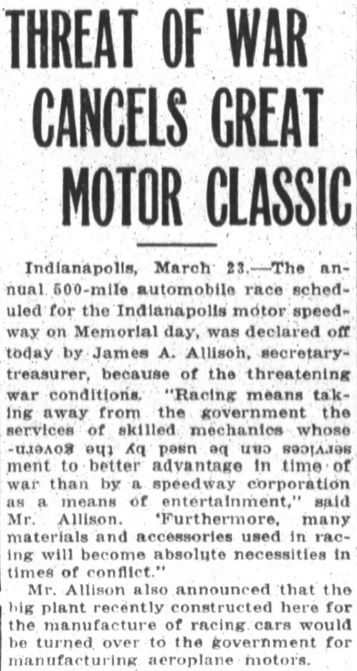
In addition to racing though, the area holds another important place in Indiana and U.S. history ─ as an innovative aviation hub during both world wars. During World War I, the track was used as a landing and flight test field and hangars built on site helped house aircraft. Just south of the track, the Allison Experimental Company manufactured parts for the Liberty Engine, arguably one of America’s greatest contributions to the war. And at Speedway’s aviation repair depot, workers restored 313 planes, 350 engines, and numerous aircraft parts. Their work helped keep our nation’s pilots in the air and made the Speedway area a center for military aviation during the war.
The United States lagged far behind the British, French, and Germans in military aviation when it entered World War I in April 1917. Those countries had been fighting for three years and in that time had understood and capitalized on the value of military aircraft for combat and reconnaissance. American entry in the war spurred rapid expansion of the industry in the country. Although time constraints forced the U.S. to purchase much of its military aircraft from the British and French during this period, the country made great strides in preparing pilots for air service abroad and in the production and repair of engines and training aircraft.
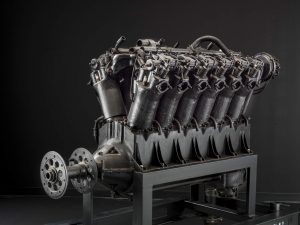
Indianapolis’ central location made it a prime site for aviation repairs and flight testing. Nearby flying fields included Chanute Field in Rantoul, Illinois and Scott Field in Belleville, Illinois, McCook Field and Wilbur Wright Field in Dayton, Ohio, and Selfridge Field in Mt. Clemens, Michigan, among others. Additionally, the proximity of railroad lines in the city and automobile centers in Ohio, Michigan, and Illinois made it easier to access raw materials such as steel, aluminum, and lumber, as well as supplies and spare parts used in repairing wrecked aircraft. Perhaps even more importantly though was the leadership of men like Carl Fisher and James Allison, co-founders of the Speedway, who dedicated their manufacturing resources in the area and the Indianapolis Motor Speedway to the war effort.

The U.S. Army established the aviation repair depot in Speedway on February 4, 1918 with the arrival of the 810th Aero Squadron from Kelly Field in San Antonio, Texas. According to William Menkel, former captain in the U.S. Air Service and commanding officer of the depot, it was the first of the repair depots to get under way and begin repairs in the U.S. Other repair depots later opened in Dallas, Texas and in Montgomery, Alabama. In addition to the 810th Aero Squadron, the Speedway depot was also home to the 809th, 811th, and 821st squadrons. 150 men served in each squadron.

In October 1918, the Speedway Dope, the newsletter of the aviation repair depot, reported that “the commissioned and enlisted personnel [at the depot] constitutes a cosmopolitan community. Mechanicians, [sic] clerks, cooks, and chauffeurs have come from all parts of the Union, and at the Speedway there is no East or West or North or South.” The majority of the civilian mechanics at the repair depot had little knowledge of aircraft before American entry in the war, but within a short time they became experts in the industry and in repair work. The U.S. Air Service established training schools for these men across the country and provided classes in engine assembly and wing and fuselage construction, while also teaching skills such as making and fastening metal parts to the aircraft, sewing fabric on wings, and applying dope varnish to the aircraft. The first wrecked aircraft arrived in April 1918.
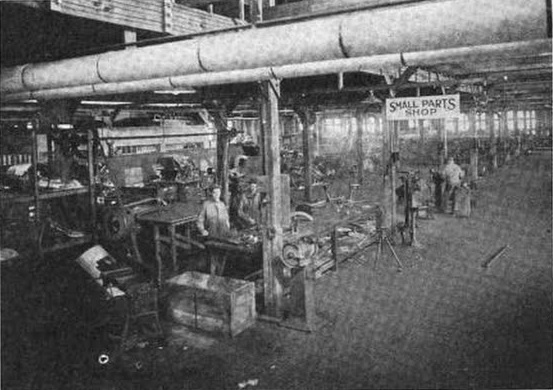
Damaged planes were unloaded and often sent to the Dismantling Department where the engine, landing gear, tail surfaces, and other parts were removed, cleaned, and worked on separately before reassembly began. While some of the planes that arrived only needed minor repairs before being shipped back out, others were total wrecks that needed to be completely rebuilt and tested.
By July, output reached three completed planes a day. Perhaps even more impressive though were the modifications made to the aircraft to help increase pilot safety. Workers at the repair depot analyzed incoming wrecks in order to find patterns in destruction. They then used this information to make improvements in design of the aircraft. For example, in his 1919 report on repair depots, Captain Menkel noted that many damaged planes that arrived in Speedway had smashed instrument boards. The instrument board was located so close to the pilot that in the case of a crash their head was likely to hit it. Workers at the depot moved the instrument boards farther away from the pilot’s seat during their repairs. This extra space reduced the chance that the pilot would hit it in a crash, thereby improving the pilot’s safety and lowering the chance of damage to the instrument board.
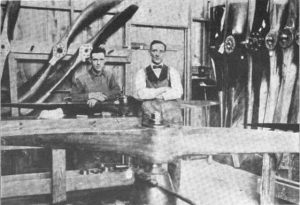
The information learned from wrecked aircraft that arrived at the depot also resulted in other modifications, including the reinforcement of longerons and other parts of the plane to lower the chances of damage or fatal injury of the pilot and cutting out sections of the cowl frame to provide more distance between it and the pilot.
In a post report to Washington in January 1919, the Speedway Dope reported 313 airplanes repaired at the depot during 1918, representing a total value of $1,195,550.00 and 350 airplane motors valued at $638,699.00. In addition to these figures, the report noted repairs of wings, ailerons, elevators, rudders, and other miscellaneous parts valued at approximately $300,000.00. Added together, repairs at the depot well exceeded $2,000,000.00. Beyond the economic benefits and savings to the government was the fact that those working at the repair depot helped keep pilots in the air, reducing their chance of injury or death and ultimately giving the U.S. a better opportunity to win the war.
Articles in the Speedway Dope reiterated these sentiments, noting that those who trained or repaired airplanes in the Speedway area might be inclined to downplay the role they played in the war because they were not in the trenches abroad or flying in France. The repair and reconstruction of airplanes was a vital part of the war effort though.

The third side of aviation has not only been neglected, but the public generally does not know that it even exists. The repair and reconstruction of damaged planes and motors, constitutes a bit part of the game of aviation. It is that part of the game that must be done and done right, or the other parts would fail to accomplish anything. True it does not carry any of the romance or glamour that follows the course of the pilot and his plane, and neither does it require the enormous financial outlay that goes with production . . . Yet this third side of aviation has been well taken care of and thousands of men who enlisted for service in France have remained at home repair depots and made it possible for others to enjoy foreign service and win international fame.
“The Third Side of Aviation-Rebuilding,” Speedway Dope, November 30, 1918, 1, accessed Indiana State Library Collections.
In the days immediately following the armistice on November 11, 1918, the Speedway Dope wrote that even though the war had ended, production at the depot should continue, as there was still plenty of work to do before completion of the final peace terms. Major Guy L. Gearhart, former commanding officer of the depot agreed. Maj. Gearhart recognized the important role the airplane would play in transportation after the war and believed the repair depot would become a permanent fixture in the Speedway.
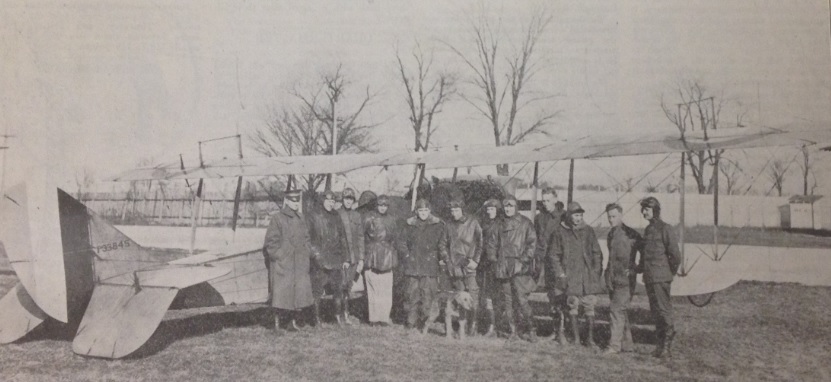
The depot’s future remained unclear though. With the war over, immediate aviation interests in the area took a backseat to racing and motorsports. The Indianapolis 500, which had been cancelled in 1917 and 1918, recommenced in May 1919. The resumption of the annual race led to questions and concerns about the track and infield being used for aircraft. Despite initial orders calling for the closing of the depot in March 1919 though, the South Bend News-Times reported that recruitment for men for the U.S. Air Service at the Speedway aviation repair depot continued as of July. By the following year, however, the status of the aviation repair depot was again called into question. Some speculated that it would be removed from the Speedway area and relocated to Fairfield, Ohio. The government officially ordered the abandonment of the repair depot in September 1920 and publicized the sale of buildings and utilities in November of that year.
Although work in the Speedway area shifted back to racing and motorsports, aviation interests did not disappear completely. The Allison Experimental Company (Allison Engineering Company by 1921), located just west of the repair depot, continued to work to improve the Liberty aircraft engine into the 1920s. When General Motors purchased the company in 1929, it expressed a commitment to expanding its work in the aviation field. It was this commitment that made the Speedway area an aviation hub once again during World War II.
Be sure to check back in a few weeks when we examine the vital role the Speedway area played in military aviation in World War II!
Sources Used and Research Note:
William Menkel, “‘New Plans for Old’: The Work of the Aviation Repair Depots,” Aerial Age Weekly, September 1, 1919, 1129-1133, 1144, accessed Google Books.
Much of the information about the aviation repair depot came from articles in the Speedway Dope. The publication ran from September 28, 1918 until February 1, 1919. Copies of the paper can be located at the Indiana State Library.
The Indiana Historical Bureau installed a new state historical marker commemorating the aviation repair depot in Speedway on April 24, 2018. Marker sponsors included Rolls-Royce North America, Rolls-Royce Heritage Trust – Allison Branch, and the Town of Speedway. For more information on the aviation repair depot and additional sources, see: https://www.in.gov/history/markers/4406.htm
